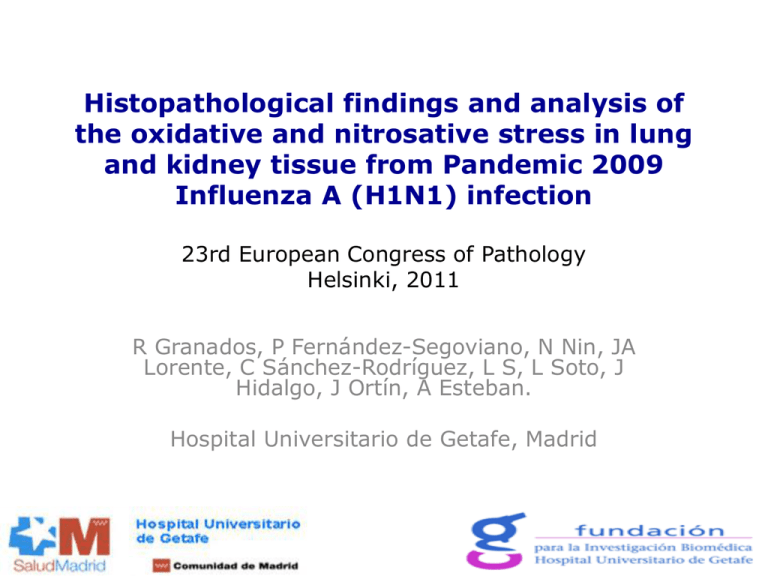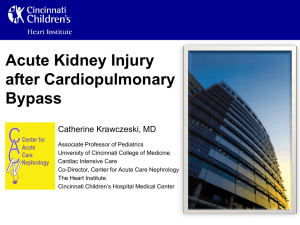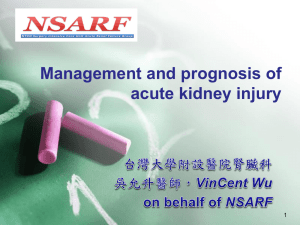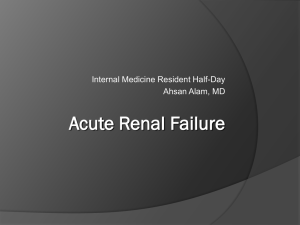Histopathological findings and analysis of the oxidative and
advertisement

Histopathological findings and analysis of the oxidative and nitrosative stress in lung and kidney tissue from Pandemic 2009 Influenza A (H1N1) infection 23rd European Congress of Pathology Helsinki, 2011 R Granados, P Fernández-Segoviano, N Nin, JA Lorente, C Sánchez-Rodríguez, L S, L Soto, J Hidalgo, J Ortín, A Esteban. Hospital Universitario de Getafe, Madrid • Influenza A virus (H1N1) may elicit severe respiratory dysfunction and acute kidney injury (AKI) leading to death. • The specific cell target for the infection has not been found. CAUSE OF DEATH Causa de Muerte Shock 17 DOM 52 Hipoxia refractaria 72 0 20 40 60 80 Epidemiologic multicenter study of 100 H1N1 patients in the ICU. Nin et al. J Critical Care 2010 Hypoxia HYPOXIA MOF 60 Shock 53 50 47 47 50 % • All patients who died, mantained refractary hypoxia during the entire course of the disease. 40 40 37 30 30 20 20 20 10 6 10 0 First week Second week Third week ARDS • They developed ARDS. • Viral continuous replication is supossed to be the cause of refractary hypoxia. 40 > Third week (mg/dl) 4 Blood levels of creatinine in the course of the disease 3.5 3 2.5 Non AKI 2 1.5 Early AKI 1 Late AKI 0.5 0 0 1 2 3 4 7 14 DAYS MORTALITY RATE 92 100 % 80 60 56 44 40 20 0 Non Aki Early AKI Late AKI N. Nin et al. ACUTE RENAL FAILURE IN CRITICALLY ILL MECHANICALLY VENTILATED PATIENTS WITH INFLUENZA A (H1N1) VIRAL PNEUMONIA. ICM SUMMITED Aims of the study • In 11 fatal cases of H1N1 infection • Postmortem lung tissue from 7 patients • Kidney biopsies from 4 patients • To analize: – Histopathological findings – Oxidative and nitrosative stress – Localization of viral particles in lung and kidney Materials and Methods • • Routine histological and histochemical analysis. Double immunofluorescence and confocal microscopic analysis for – Specific markers of nefron segments and alveolar cells: • aquaporin 1 and CD10: proximal tubules • Nefrin: podocytes • CK7: distal tubules • Aquaporin 5: pneumocytes type 1 • Surfactant protein: pneumocytes type 2 • CD68: macrophages – Oxidative and nitrosative stress markers: • oxidized dihydroethydium (DHE): presence of oxygen free radicals. • inducible NO synthase (iNOS): increased NO. • nitrotyrosine (NT): protein nitration, superoxide anion and NO. – Human influenza nucleoprotein (NP): antibodies after rabbit immunization with purified recombinant NP. Results in pulmonary pathology I • Diffuse alveolar damage: exudative and proliferative patterns with alveolar and interstitial edema, reactive pneumocytes, fibrinous exudate, hyaline membranes and mild inflammation. • Pulmonary hemorrhage. • Necrotizing bronchiolitis with destruction of bronchiolar wall and severe acute inflammation. • Fibrosis in one patient (45 days of clinical course). 26 yo female who died with severe hypoxemia 2 h after admission Extensive exudate of fibrin-rich edema fluid in the alveolar space A postmortem sample from a 16 yo male 8 days after ICU admission Diffuse alveolar damage: hyaline membranes lining the alveolar spaces and inflammatory infiltrates Necrotizing bronchiolitis with desquamation and necrosis of bronchial epithelium A 37 yo male with H1N1 infection who died 16 days after ICU admission Type I pneumocytes Type II pneumocytes A 32 yo female dead 45 days after hospital admission for H1N1 viral infection Interstitial fibrosis with thickening of the muscular artery wall Results in pulmonary pathology II Nitro-oxidative stress • Increased oxidative and nitrosative stress measured by IF in lung tissue by – – – oxidyzed dihydroethidium (DHE) iNOS protein protein nitration (Nitrotyrosine) Nitrosative and oxidative stress markers in lung tissue Control Disease Oxidation (DHE) A B iNOS C D Nitration (NT) Blue: DAPI in nuclei Red: marker Results in pulmonary pathology III H1N1 influenza virus detection in lung tissue Double staining colocalizing H1N1 virus in the lung A B * * A) Immunofluorescence for type I pneumocytes (aquoporin 5 positive cells in green with asterisks) and viral nucleoprotein (in pink). A type I pneumocyte containing viral nucleoprotein is observed (arrow)(confocal scanning microscopy,original magnification x 63). B) Immunofluorescence for macrophages (CD68 in green) and viral nucleoprotein (in red). Macrophages containing viral nucleoprotein are identified (confocal scanning microscopy, original magnification x 63). Results in kidney pathology I • The histology from the 2 patients with AKI showed acute tubular necrosis (ATN) in distal tubules. • There was increased nitrosative and oxidative stress markers (DHE, iNOS and NT) in the renal cortex of patients with kidney failure, but not in those with normal renal function. • Cases with AKI selectively showed viral NP immunoreactivity in distal tubules and in parietal Bowman´s capsule epithelium. Histopathological findings • Focal acute tubular necrosis of distal tubules in 2 of 4 cases: epithelial cell swelling, mitoses, necrosis and intratubular cell shedding. ATN Normal glomeruli Focal ischemic signs Superoxide levels by dihydroethydium probe in renal tissue from Influenza A patients A 23 yo female without renal failure A 60 yo male with a creatinine increasing to 4.7 mg/dl. Nitric Oxide inducing enzyme (iNOS) IF in kidney from infected patients No renal failure Anti-iNOS 100x Renal failure Virus localization with NP antibody IF Bowman’s capsule Anti-NP 40x Renal tubule Anti-NP 100x NP CD10 VIRUS IN RENAL DISTAL TUBULE (AQP1 +NP) 4663-09 Red: Viral NP Blue: nuclei (DAPI) Green: AQP1 Conclusions • Fatal H1N1 viral infection causes ARDS and acute tubular necrosis in distal tubules. • The disease courses with prolonged oxidative and nitrosative stress in lung and renal cortical tissue. • Viral particles are seen in distal tubules, Bowman´s capsule, type 1 pneumocytes and alveolar macrophages. • These findings suggest persistent viral replication despite antiviral treatment. Gracias Centro Nacional de Biotecnología, CSIC, Madrid, Spain. Juan Ortín, Lorena Ver ARGENTINA CHILE ESPAÑA URUGUAY Hospital Posadas Hospital Instituto Nacional del Tórax Hospital de Getafe Hospital Maciel Hospital Austral Univ. Catolica Hospital Militar Hospital Santojanini Clínica Indisa Hospital Español Sanatorio Velez Hospital de Concepción Sanatorio CASMU Sanatorio Legomagiore Sanatorio CUDAM







